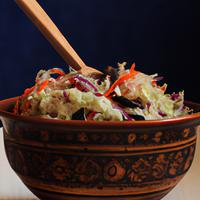
1 serving (100 grams) contains 152 calories, 1.0 grams of protein, 10.4 grams of fat, and 14.1 grams of carbohydrates.

Log this food in SnapCalorie

Nutrition Information
Calories |
152 | ||
|---|---|---|---|
% Daily Value* |
|||
| Total Fat | 10.4 g | 13% | |
| Saturated Fat | 1.5 g | 7% | |
| Polyunsaturated Fat | 0 g | ||
| Cholesterol | 10 mg | 3% | |
| Sodium | 216 mg | 9% | |
| Total Carbohydrates | 14.1 g | 5% | |
| Dietary Fiber | 2.3 g | 8% | |
| Sugars | 11.3 g | ||
| protein | 1 g | 2% | |
| Vitamin D | 0 mcg | 0% | |
| Calcium | 40 mg | 3% | |
| Iron | 0.4 mg | 2% | |
| Potassium | 140 mg | 2% | |
* Percent Daily Values are based on a 2,000 calorie diet. Your daily values may be higher or lower depending on your calorie needs.
Food Attributes
Source of Calories
About Half a cup of coleslaw
Half a cup of coleslaw is a classic side dish often associated with American barbecue, picnic spreads, and global interpretations of comfort food. Traditionally made from shredded cabbage, carrots, and a creamy dressing—typically mayonnaise or yogurt—it offers a balance of crunch and creaminess. Variations may include vinegar-based dressings for a tangier, lower-fat option. Nutritionally, coleslaw provides dietary fiber from the cabbage and carrots, as well as vitamins C and K, essential for immunity and bone health respectively. However, the calorie and fat content can be higher depending on the dressing used, so it’s wise to consume in moderation or opt for lighter dressings when possible. Its adaptability makes coleslaw a versatile dish, pairing well with grilled meats, sandwiches, or as a topping for tacos and sliders.



